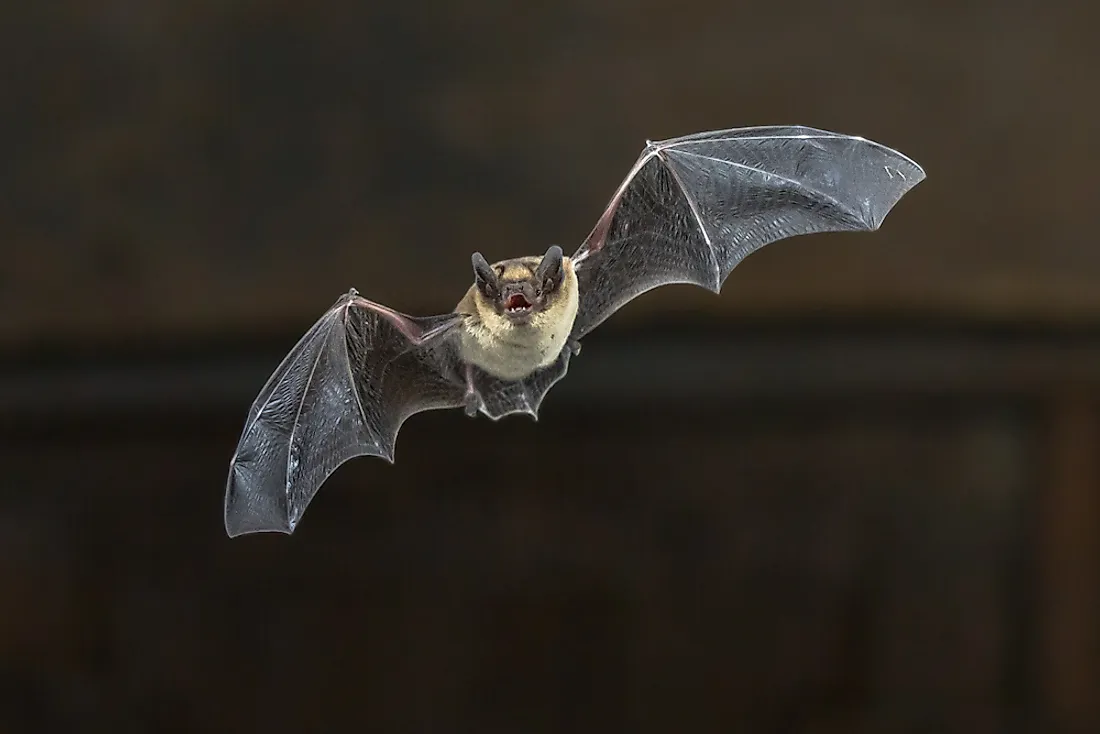Are There Any Mammals That Can Fly?

Bats are the only mammals with the ability to fly. Bats are classified in the order Chiroptera, which is further subdivided into Yangochiroptera and Yinpterochiroptera suborders. The forelimbs are developed to become wings which enable them to sustain a flight. Their long spread out wings are covered by a thin patagium that makes them maneuver easier than birds.
Most bats are either insectivorous or frugivores while a few species consume blood. Bats are known to be nocturnal and are an important agent of pollination and seed dispersal. The smallest bats are Kitti's hog-nosed variety which measures between 1.14 to 1.34 inches long, weigh about 2.6 grams and have a wingspan of 5.91 inches. The largest recorded bats are the giant golden-crowned flying fox and flying foxes which grows to a weight of 1.6 kg with a wingspan of 1.7 meters.
Wings And Flight
The unique adaptation of bats that enables them to fly is the flexible finger bones which have a flat cross-section and low calcium levels towards the tip. The digits are long because of upregulation of the bone morphogenetic proteins that aid in wing development. During flight, the bone undergoes smaller bending stress but larger shearing stress compared to other terrestrial mammals. Bats have wing bones that have a lower breaking stress point than ordinary flying creatures like birds. The 5 elongated digits of the bat radiate around its waist with the thumb pointing forward to support the upper edge of its wings while the remaining 4 digits support the tension from the wing membrane. The 2nd and 3rd digits support the wing tips thereby allowing the wings to be pulled forward and backward against the aerodynamic drag. The 4th and 5th digits go from the wrist to the trailing edge to assist in repelling the bending force from air pushed up against the stiff membrane. The membranes are quite delicate and tear easily but can heal or regrow. Bats have flexible, maneuverable joints that make them fly swiftly. The wings are thin specialized limb which makes bat fly with less drag and more lift. When a bat folds wings towards the body on the upstroke, it saves about 35% energy during flight.
The Merkel Cells
Bats are able to detect any change in airflow from a tiny hair which acts as a touch receptor located on the surface of the wings. The touch receptor, known as the Merkel cells, enable the bat to decide on the most efficient speed to avoid hitting stalls since it is a nocturnal animal.
Roosting Adaptations
Bats hang upside down on trees when they are not flying, a posture known as roosting. Most microbats roost with their neck curled towards the back whereas most megabats roost with their head tucked towards the belly. This difference in roosting between the two is because they have a different structure of the cervical or neck vertebrae. Tendons enable bats to lock their feet on trees while muscular power is required to let go.
Other Adaptations
During the flight, bats use echolocation, a phenomenon where bats emit ultrasonic sound to produce echoes. Such echoes are useful in locating any obstacles around and detect predators. Bat ears are sensitive to sounds produced by some insects and the fluttering of moth wings. In blood circulatory system, bats’ veins actively support the backflow of blood to the heart. However, bats are not at risk of blood flowing back to their heads during roosting due to their small and lightweight bodies. Bats have a mesopic vision and can only detect light of low levels – therefore, they are not blind as some people believe.











